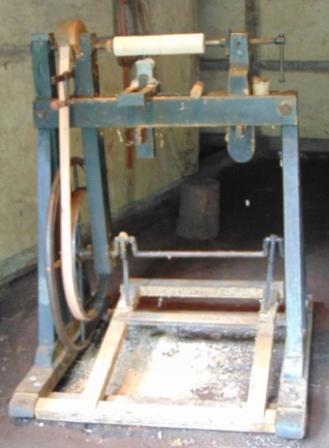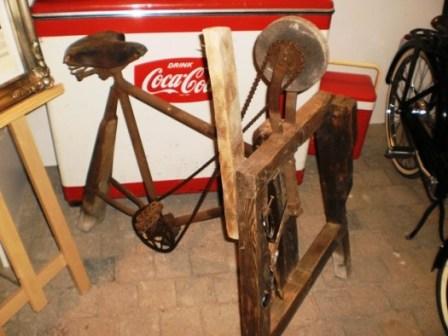Many crafts can be done easily and quickly by using machines. Before there were electricity and fuel engines, man already made devices that were driven by manpower, animal power or hydropower. Also wind and steam were used. With an inventive spirit a lot is possible.
 The easiest example, of which other machines can be identified, is the (wood) lathe. You can thus turning chair legs, (spin and side) bobbins, chess pieces, plates and bowls. Depending on the available material and the inspiration and skill, there are several models. We describe some principles, with increasing complexity. On You Tube and through search engines, there are a lot of handsome movies to find.
The easiest example, of which other machines can be identified, is the (wood) lathe. You can thus turning chair legs, (spin and side) bobbins, chess pieces, plates and bowls. Depending on the available material and the inspiration and skill, there are several models. We describe some principles, with increasing complexity. On You Tube and through search engines, there are a lot of handsome movies to find.
The easiest and effective working lathe is the fire bow.
Instead of keeping the bar vertical you mount it horizontally between two pins (or bowls). Preferably with as little friction as possible, so that it can run smoothly.
Make sure you can move and secure one pin, so you can run as well smaller and larger pieces.
Mark the spot where you can mount the workpiece centered, otherwise it’s going to swing and you can turn off nothing.
Use sharp chisels, and polishing them periodically.
Shaping happens with little bits, every time the piece turns to you.
The disadvantage of this method is that you have to 'saw' with 1 hand. That makes it difficult to handle a chisel with the other one (fixed?) hand.
It's a lot easier if you make a (movable) guide (tool rest) where you can support the gauges.
And even easier if you have a helper who can provide the rotation.
All of these aids apply equally well to the following models.
Instead of horizontally, you can use the bow upright.
If you attach it to a supple branch, you just have to pull down. The resilience of the branch takes care of the movement upwards.
If you do not have a suitable tree nearby, attach a lithe, long pole diagonally into the ground. With that you can work the same way (spring pole lathe).
For the next step you just drop the arch. Underside on the rope you fix a kick board (pedal), best with a hinge so it does not crawl away. With your foot you can exert more force, and you get two hands free to work. A great improvement. Te much longer the board is, the more spins your turning piece can make per pedal movement.
For the next improvement we peek at the spinning wheel and the old treadle sewing machine. You keep the pedal, but it goes eccentrically fixed to a wheel off side the pedal. By pedalling the wheel continues to spin. With a string on the rim of the wheel, you bring the movement to your work. (This can also with gears or a chain.) The new benefit is that you work no more running back and forth, but the spinning direction stays the same. That works more than twice as fast.
You can weigh the wheel, e.g. make it wider (double) and fill with compacted clay. It gets a flywheel function.
 It can be even more powerful when we go to two pedals. To do this, use your bike parts: pedals, gears and chain. With extended axes, you can also transfer the movement from the side to your workpiece.
It can be even more powerful when we go to two pedals. To do this, use your bike parts: pedals, gears and chain. With extended axes, you can also transfer the movement from the side to your workpiece.
The moving axis is not only to be used as lathe. You may power a grindstone, a circular saw, disc sander, a band saw, a planer, a drill, a dynamo... with it.
If you want to use saws and planes (shaves), ask someone else to kick. You have your concentration and balance required to work without loosing (pieces of) your fingers. You can even make a good firewood saw that way.
Because you use the motion directly, and not first makes energy to transfer this back into motion you get a high return.
For those who find it a crazy idea: you're probably right. You better spend money and energy wasting fuel and electrical appliances. And besides that go to fitness and exercise bike. Or is this even crazier?
http://www.lowtechmagazine.be/2011/05/fietsmachines.html
